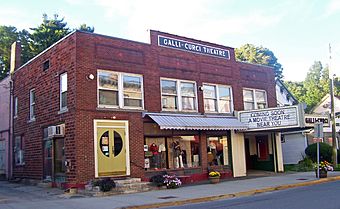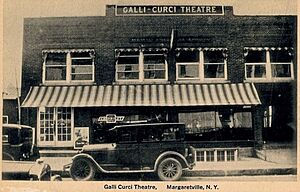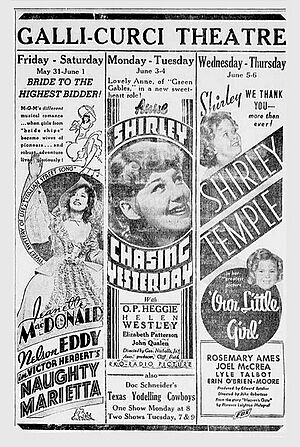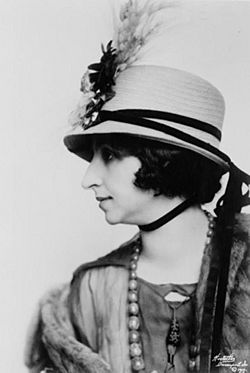Galli-Curci Theatre facts for kids
Quick facts for kids |
|
|
Galli-Curci Theatre
|
|
 |
|
| Location | Margaretville, NY |
|---|---|
| Nearest city | Oneonta |
| Built | 1922 |
| NRHP reference No. | 06000254 |
| Added to NRHP | March 15, 2006 |
The Galli-Curci Theatre is a historic building in Margaretville, New York. It is located on Main Street, which is also NY 30. This brick building was built in the 1920s. Today, it is mostly used as a store, but some parts of the original theater are still there.
The theater was named after a famous opera singer named Amelita Galli-Curci. She spent her summers at her country home near Margaretville from 1922 to 1937. She even sang at the theater's opening night!
A local businessman named Clarke Sanford built the theater. He wanted to create a place for new businesses in the area. It first housed a car dealership, a silent movie theater, and offices for the Catskill Mountain News newspaper. The building continued to show movies until 1985. After that, it was changed into an antique store. However, most of its original movie theater features remained. In 2006, the Galli-Curci Theatre was added to the National Register of Historic Places. This means it is a special building with historical importance. Today, it is a jewelry store and office space.
Contents
Exploring the Galli-Curci Theatre Building
The Galli-Curci Theatre is on the west side of Main Street. This area is busy, with many older buildings from the late 1800s and early 1900s. These buildings often have shops on the first floor and homes or offices above.
The theater building has two main parts. The front section is about 50 feet wide and 142 feet deep. This part has the store and the theater entrance. It is a two-story brick building with a strong concrete base.
The front of the building has a storefront with large glass windows. There is also a double-door entrance at one end. The theater entrance is at the other end. It has a special roof called a marquee that says "Galli-Curci" on it. On the second floor, there are pairs of windows with brick frames. The flat roof has a large wooden sign that proudly says "GALLI-CURCI THEATRE."
The back part of the building is the auditorium section. It is made of concrete blocks covered in stucco. The roof slopes gently from the front to the back, just like the floor inside. There is a brick chimney on one side of the roof. You can also see the tops of two wooden supports, called trusses, which were added later to make the building stronger.
Inside the front part, the store still has its original floor and a special metal ceiling. The upstairs area, which used to be offices, also has its original floor and decorative trim. Two double doors with half-moon glass panels lead into the theater area.
A narrow, carpeted hallway leads up to the main auditorium. Here, a flat wooden floor was built for the antique store after the theater closed. Some of the original wooden walls that separated the lobby are still there. They even show colors from the 1940s! The ceiling is plain plaster, and modern lights have replaced the old ones.
A Look Back at the Theatre's History
The Galli-Curci Theatre was very popular when it first opened. However, things changed after World War II. The theater faced challenges but kept showing movies under different owners until the mid-1980s. In 1987, it was changed into a large antique shop. There were plans in 2005 to turn it back into a theater, but that did not happen. Since 2019, the building has been a jewelry store and office space.
1922–1942: Early Success and New Ideas
Clarke A. Sanford came from a family that owned the local bank. He had been a teacher and a reporter before buying the local newspaper, the Catskill Mountain News, in 1904. In 1907, he was the first person in Margaretville to own a car! Local stories say he crashed it into a farm building.
Seven years later, in 1914, Clarke Sanford and a partner opened the first car dealership in town. They sold popular car brands like Buicks, Fords, and Packards. The dealership was in a new building that Sanford had built for his newspaper.
On the upper floor, Sanford brought another new invention to Margaretville: movies! He started charging people to watch silent films that year. His wife even made the popcorn. The movies were very popular. This was because the local economy was doing well, and many tourists visited in the summer. The movies needed more space.
In 1922, Sanford built the new theater. It even had a player piano to play music during the silent films. He put the car dealership on the first floor. The newspaper's offices were upstairs, and its printing press was downstairs. Other offices were rented to the Delaware and Northern Railroad.
Sanford offered to name the theater after Amelita Galli-Curci. Her large estate was nearby in Highmount. He asked her to sing at the opening night in 1922, and she did! She ended her performance with the song "Home! Sweet Home!"
Clarke Sanford held many local political jobs. He later became one of New York's first Commissioners of Motor Vehicles. In 1930, he added sound to the theater. This meant movies could now have talking and music! The theater continued to do well enough to support the car dealership, even during the Great Depression. The theater also hosted live shows, like touring plays, local theater groups, and school events. His son joined the business, and by the end of the 1930s, the family also ran another theater in Fleischmanns.
1942–1964: Facing Challenges
In 1942, the railroad company closed down, and the newspaper took over its offices. Four years later, in 1946, the Sanfords rented the theater to the Kallet movie chain. The agreement was that the Sanfords would keep the money from the snack bar, and Kallet would make improvements. Two years later, Kallet started a big renovation inside the theater. They filled in the orchestra pit to add more seats. The wooden supports, or trusses, that you can see on the roof were added around this time.
However, the theater faced new problems. After World War II, New York City continued its plans to expand its water supply system. This meant building the Pepacton Reservoir nearby. Many towns were lost because of this project, including the Sanford family farm. This affected the local economy. Also, television became popular and started to take away movie viewers. In 1955, Kallet changed the theater again to show widescreen movies. Movie studios started making these bigger movies to compete with the small TV screens.
Three years later, in 1958, the Sanfords took back control of the theater. But the number of people coming to movies kept going down. In 1963, Clarke Sanford successfully claimed money for his lost business. This was from a special group set up to help people affected by the reservoir's construction. He passed away the next year.
1964–Present: A New Chapter for the Building
Clarke Sanford's son, Roswell, took over the newspaper and theater. He soon moved the newspaper to a different office. He also changed the second floor of the theater building into an apartment. Roswell then sold the theater to Donald Conine, who later sold it to Ben Resnick in 1975. Resnick continued to show movies until 1985. By then, home video players became very popular, which made it even harder for movie theaters to attract audiences.
The auditorium was then used for live music shows. In 1987, new owners, the Goths, bought the building and changed its purpose completely. They put in the wooden floor and started selling antiques. They also removed the old movie projection and sound equipment. Later, the building became empty again. In 2005, two new owners bought it. They planned to turn it into a movie theater with several screens, but their plans did not work out.
In 2018, a designer from Iceland named Jóhanna Methúsalemsdóttir bought the building. Since 2019, she and her partner Paul Weil have been running a jewelry store called Kria Jewelry in the former theater.
See also




